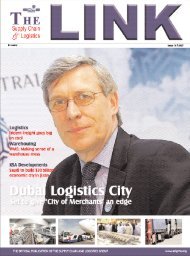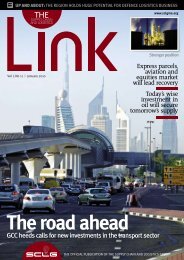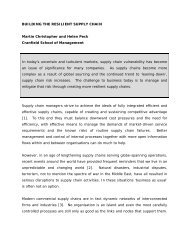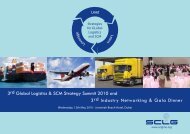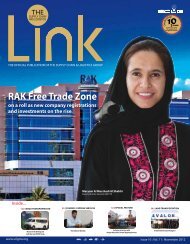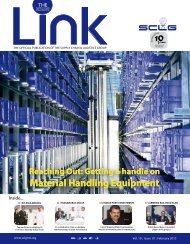Free to Download - SCLG
Free to Download - SCLG
Free to Download - SCLG
- TAGS
- download
- sclg
- sclgme.org
Create successful ePaper yourself
Turn your PDF publications into a flip-book with our unique Google optimized e-Paper software.
IRELAND SPECIAL Business<br />
Critical Success Fac<strong>to</strong>rs in<br />
the Re-engineering of 21st<br />
Century Supply Chains<br />
The changing business environment has sharpened<br />
the focus on the need for robust approaches <strong>to</strong> supply<br />
chain improvement.<br />
This article sets out the key elements<br />
of traditional re-engineering<br />
processes. It goes on <strong>to</strong> outline some<br />
of the key characteristics of SCM excellence,<br />
based on the author’s experience and on<br />
documented evidence in the literature.<br />
Based on the performance of firms in<br />
relation <strong>to</strong> these key characteristics, a<br />
number of critical success fac<strong>to</strong>rs (CSFs)<br />
for effective supply chain re-engineering<br />
are identified and the key elements of a<br />
roadmap are proposed.<br />
Organisational Re-engineering<br />
Companies have long realised the need for<br />
company-wide approaches <strong>to</strong> organisation<br />
design and redesign. The development<br />
of systems engineering approaches <strong>to</strong><br />
manufacturing system redesign in the 1970s<br />
and 1980s was followed by the focus on<br />
organisational re-engineering, often based<br />
on business processes, in the 1980s and<br />
1990s. A common feature of all of these<br />
approaches is a recognition that “the<br />
whole is greater than the sum of the parts”.<br />
In other words, optimising subsystems<br />
(whether those subsystems are functional<br />
departments, production sites or individual<br />
processes in the manufacturing cycle) can<br />
result in a sub-optimised <strong>to</strong>tal system. Lack<br />
The increasingly<br />
international nature of<br />
markets and companies<br />
has resulted in many<br />
companies becoming<br />
part of large and complex<br />
global supply chains<br />
12 Link January 2011<br />
of efficiency and/or effectiveness is often<br />
a result of the poorly designed interfaces<br />
between subsystems rather than any<br />
inherent subsystem weaknesses. There<br />
are numerous examples of companies who<br />
have generated significant improvements<br />
in competitive advantage as a result of the<br />
application of this “<strong>to</strong>tal systems” thinking.<br />
A product is delivered <strong>to</strong> the ultimate<br />
cus<strong>to</strong>mer through a complex interaction<br />
of several companies on the way. The<br />
supplier’s ability <strong>to</strong> give the cus<strong>to</strong>mer<br />
what they want, when they want it, at<br />
the price and quality that they want, is<br />
not just determined by the efficiency<br />
and effectiveness of the supplier’s own<br />
operation. Inefficiencies anywhere in the<br />
supply chain will reduce the chances of the<br />
supplier competing successfully. Without a<br />
proper focus on “<strong>to</strong>tal” (i.e. integrated) SCM,<br />
therefore, a company will never achieve its<br />
true competitive potential. The increasingly<br />
international nature of markets and<br />
companies has resulted in many companies<br />
becoming part of large and complex global<br />
supply chains. In addition, the potential<br />
benefits associated with emerging ICT<br />
solutions provide the opportunity <strong>to</strong><br />
simultaneously improve cus<strong>to</strong>mer service<br />
levels and <strong>to</strong> reduce supply chain costs.<br />
These fac<strong>to</strong>rs have sharpened the focus on<br />
the need for improvements in all aspects of<br />
supply chain performance.<br />
Characteristics of SCM<br />
Excellence<br />
So what are the characteristics in evidence<br />
in companies that might be regarded<br />
as world class. “World Class” in this<br />
context means companies that have been<br />
successful in <strong>to</strong>ugh, competitive international<br />
Edward Sweeney<br />
markets over a sustained period of time. It<br />
is impossible <strong>to</strong> develop an exhaustive list<br />
of the characteristics of SCM excellence but<br />
the following four elements appear <strong>to</strong> be of<br />
critical importance for most companies in<br />
most sec<strong>to</strong>rs:<br />
uIdentification and measurement of<br />
cus<strong>to</strong>mer service because cus<strong>to</strong>mer service<br />
‘sets the spec’ for supply chain design<br />
uIntegration of supply chain activities and<br />
information because many supply chain<br />
NVAs are caused by fragmented supply<br />
chain configurations<br />
uSCM a senior management function<br />
because SCM is a strategic activity<br />
uEstablishment and measurement of<br />
supply chain key performance indica<strong>to</strong>rs<br />
(KPI’s) because what gets measured gets<br />
done!<br />
This is based on documented evidence<br />
of SCM “best practice” and allies with the<br />
author’s experience. These characteristics<br />
form the basis of a roadmap for effective<br />
supply chain re-engineering.<br />
Supply Chain Re-engineering<br />
Improving supply chain performance through<br />
re-engineering involves: analysis of internal<br />
and external parameters using relevant data<br />
which has been collected; the identification<br />
and evaluation of possible alternative




